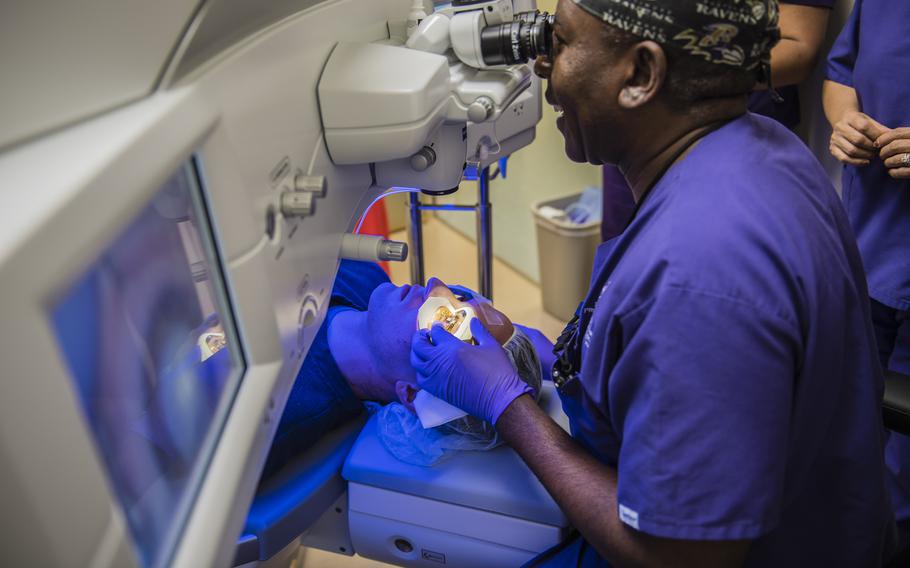
Laser-eye surgery is performed on a patient at the Warfighter Refractive Eye Surgery Program and Research Center at the Belvoir Hospital, Fort Belvoir, Va., March 16, 2017. (Reese Brown/Department of Defense)
TRIPLER ARMY MEDICAL CENTER, Hawaii — Patients seeking laser eye surgery can expect longer wait times at this Army hospital as its refractive center transitions from contractors to in-house ophthalmologists for the procedures.
The medical center ended its contract last month for outside staffing of its refractive center due to lack of funding, Tripler’s commander, Col. Michael Ronn, said Thursday at his headquarters.
“At the end of last [fiscal year], we needed to make some decisions on contracts that we were going to keep or let go in order to get to fiscal solvency,” he said. “Every year we have to make some of those kinds of decisions, but last year we had to make a few more decisions than we usually do.”
The fiscal year ended Sept. 30.
Ronn acknowledged that some patients already scheduled were frustrated with the gap in laser eye services, commonly called LASIK, to correct nearsightedness, astigmatism or farsightedness as the medical center’s team of ophthalmologists assumed the duties.
“That gap was relatively short,” he said, adding that the medical center rescheduled roughly half of 36 patients who were in the pipeline for laser surgery.
Personnel from Madigan Army Medical Center at Joint Base Lewis-McChord, Wash., flew to Hawaii to help treat patients, Ronn said.
Moving forward, however, Tripler will perform fewer laser surgeries.
The contracted employees handled a monthly average of 51 laser eye surgeries from 2018 through 2020, Ronn said.
The monthly average dropped to 33 per year during the coronavirus pandemic.
The goal is to average 20 procedures per month under in-house personnel, he said.
“The number of surgeries that we’re able to do is not quite as much as it was before when we had the full program through contract, but it’s definitely enough to be able to meet demand,” Ronn said.
“From what I’m tracking, and from what I understand, everybody that we were taking care of is being taken care of.
“If anything is going to change a little bit, it’ll just be that the time from when a patient comes in to when they actually have their surgery done may just be a little longer than it had been in the past because we’re not doing quite as many procedures.”
Tricare does not cover the cost of refractive surgery if done outside the military health system, Ronn said.
Active-duty service members get priority in scheduling the procedure.
“Ultimately, that’s what the program is for — to be able to get service members the refractive surgery that they need so that when they go down range they don’t have to mess with glasses or contacts,” Ronn said.
The Defense Department began the Warfighter Refractive Eye Surgery Program in 2000, according to a July 2021 Army news release.
Its purpose was “to enhance vision on the battlefield, improve readiness, retain or qualify military members in occupations demanding excellent uncorrected vision, and to make headgear and goggles less burdensome,” the release states.
“Glasses can dislodge, fog or be lost, putting the military member and team at additional risk,” Air Force Lt. Col. James Townley, a refractive surgery consultant, said in the release.
“Contact lenses are not allowed in deployed conditions due to their propensity for infection,” Townley said. “Eliminating the need for distance correction, particularly when service members deploy, avoids these risks.”
Ronn said he sees a readiness-related upside to putting the laser eye procedures back into the hands of the medical center’s staff.
“What this has done is allowed them to get back into doing refractive surgery, whereas in the past, when the contractor was doing most of that work, they weren’t very involved at all,” he said. “And, so, we’re kind of rebuilding those skills within our eye doctor team.”